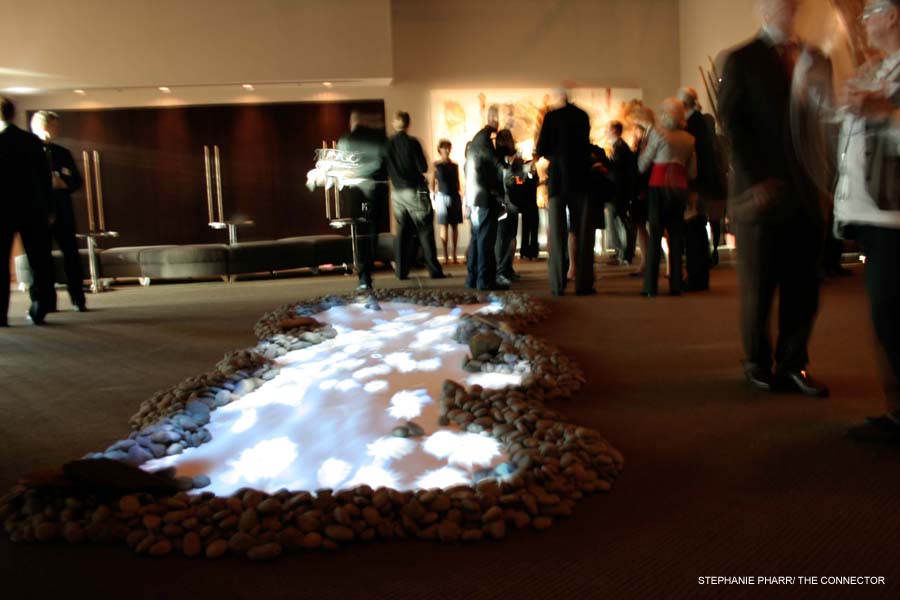Like a proud parent, SCAD showed off its new baby — and the oohs and aahs were plentiful. The baby is the 60,000-square-foot building SCAD acquired and transformed into its Digital Media Center. Oct. 7 marked the grand opening of the DMC, the fifth building to join SCAD’s growing Atlanta location.
Invited guests from the surrounding community and elsewhere poured in to tour the three-story facility, which boasts 12 classrooms, a green-screen stage, a 75-seat screening room, a Foley sound stage, a TV studio, labs and a gaming lounge.
Among the guests were people who remember the building before it belonged to SCAD, including Jim Summers, whose son Ricky Summers is an interactive design and game development major at SCAD. The elder Summers, a retired astronomer, said he used to visit the building when it was home to Atlanta’s NBC affiliate, WXIA-TV.
“It’s impressive,” Summers said of the DMC. “A whole lot better than when it was a TV station.”
Barry Compton, vice president of H.J. Russell & Company, a construction and real estate firm, recalled what the DMC could have been.
“We almost bought it out from under [SCAD] for Atlanta Public Safety,” Compton said. “But I’m glad [SCAD] got it. I think the arts of Atlanta need to stay in this core [area], and I think this is a great addition to the core.”
But despite the building’s history, the grand opening was all about showing off its future.
Along with the stroll through the DMC’s Zen-inspired interior, guests got to munch on hors d’oeuvres, ask questions and see it all in action.
On hand to answer some of the questions were SCAD President Paula Wallace; Executive Adviser to the School of Film, Digital Media and Performing Arts Scott Ross; and Dean of the School of Film, Digital Media and Performing Arts Peter Weishar, all who mingled and chatted with guests throughout the evening.
Their most highlighted point of the night: Everything in the facility is state-of-the-art and industry-standard.
In choosing the equipment for the DMC, “we were thinking about what students will be doing in five or six years,” Weishar said of the facility, especially its television studio. “Most news studios are just switching over to this.”
Actually, SCAD may be a little ahead of the industry, said Chris Sweigart, a reporter and director of social media at 11 Alive news, who worked at the 1611 W. Peachtree St. location before the WXIA moved to its current home at 1 Monroe Place.
“I think students are going to be disappointed when [they] get into the real world because the equipment is not nearly as good as it is here.
“Enjoy playing with the toys while you can,” he joked.
The toys of the TV studio make up a fully functional, all-digital control room, designed to double as a classroom, Weishar said. Guests served as a live audience in the studio during the production of “SCAD Night Live,” featuring the Honeybees Performance Ensemble.
Several students and professors were positioned in the classrooms and labs throughout the DMC, eager to demonstrate the workings of some of the building’s other gadgetry.
Interactive design and game development students offered guests a hands-on gaming demonstration. Guests used Tegra, a new hand-held device, to play an augmented reality game students created in collaboration with Georgia Tech students. The object of the first-person action game, played with a 2-D map and Skittles candy “bombs,” is to kill zombies and escort civilians to safety.
In another room, visual effects students captivated guests by using Houdini 3-D animation software to create fire, water and smoke.
Some put their sketch pencils to work to demonstrate the hand-drawn, 2-D animation process, like that used in Disney animations. Others tinkered with fired clay figures, cutouts and hand-drawn mouths and eyes, giving visitors a glimpse into the world of stop-motion animation — one of SCAD Atlanta’s newest majors.
Animation professor Becky Wible Searles helped students demonstrate and explain stop motion. Wimble Searles, who once owned a stop-motion animation studio in New York and helped launch the stop-motion program in Savannah, described the technique as sculptural animation, similar to that used to create characters like the old children’s favorite Gumby.
“SCAD is using the same techniques as professionals,” Wimble Searles said.
An idea students find “awesome.”
“I feel like they’re spoiling us because there’s so much fancy stuff here,” said Miranda Bradley, a third-year animation major.
While students feel spoiled, President Paula Wallace calls students and graduates the inspiration behind the facility.
“Their high level of work in digital media – from motion media design to television producing – demands a specialized environment,” Wallace said in a news release.
And it’s an environment SCAD hopes will draw more students to the university, said Heather Lund, a SCAD alumna and transfer admission counselor.
“I think that once people see the industry-standard facilities and equipment we have to offer our students, they’ll see that it’s worth the tuition,” she said.




















